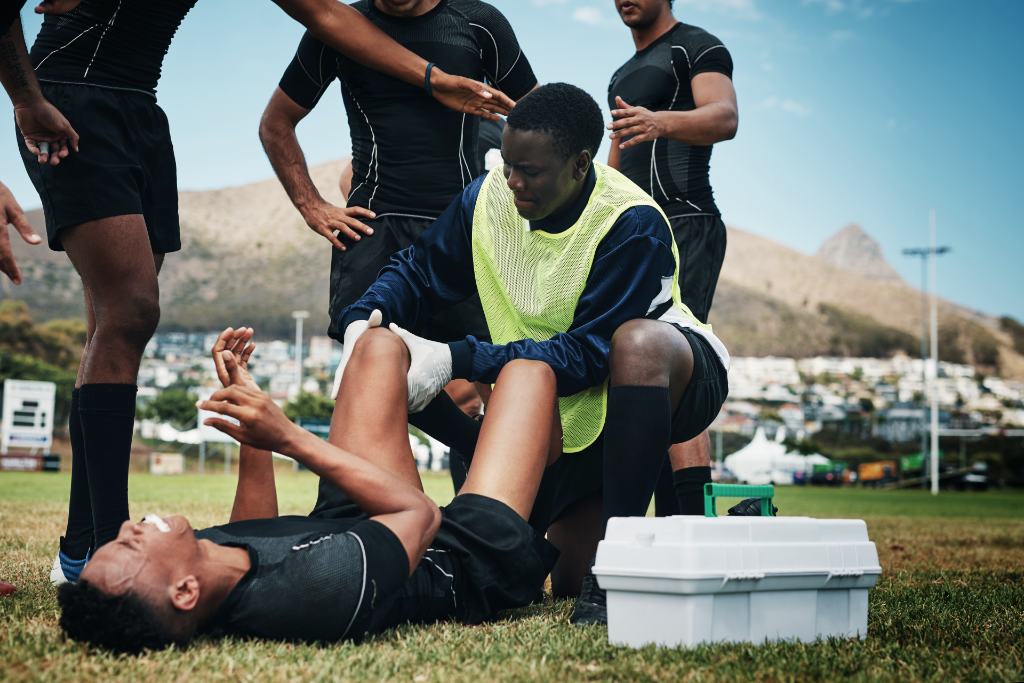 You hear a sudden pop, then feel a wave of pain. You might notice swelling that creeps in and stiffness that just won’t let up. If you’ve recently injured your knee and these symptoms sound familiar, you might be wondering: how do I know if I tore my ACL?
You hear a sudden pop, then feel a wave of pain. You might notice swelling that creeps in and stiffness that just won’t let up. If you’ve recently injured your knee and these symptoms sound familiar, you might be wondering: how do I know if I tore my ACL?
It’s a common question, especially among athletes and active individuals. A combination of ligaments helps keep your knee stable. But when you experience a tear, it’s not always clear right away. Whether you heard a snap during a sports game or twisted your knee walking down the stairs, understanding the signs of an ACL tear and what to do next is essential.
Let’s break down what the ACL is, what happens when it’s torn, how to spot the symptoms, and what your treatment options look like. We’ll also cover the difference between an ACL and MCL injury and how professionals like orthopedic doctors, physical therapists, and chiropractors can help you recover.
What Is the ACL?
Let’s start with the basics. The ACL stands for anterior cruciate ligament and is one of the four main ligaments in your knee joint. It runs through the center of your knee, connecting your thigh bone (femur) to your shin bone (tibia). The ACL is responsible for stabilizing your knee, especially during movements like pivoting, turning, or suddenly stopping. Because of this, it’s especially vulnerable to injury during sports like basketball, soccer, football, skiing, and even non-sport activities that involve quick changes in direction or awkward landings.
What Is a Torn ACL?
A torn ACL happens when the ligament is stretched beyond its range of motion, which can lead to a partial or complete tearing of the fibers. An ACL injury can range from a mild sprain to a full rupture, and the severity of the tear often determines your symptoms and treatment. Many people ask, “How do you know if your ACL is torn?” The answer depends on several factors, including how the injury occurred, the intensity of your pain, and how your knee feels afterward.
Signs and Symptoms of a Torn ACL
So, are you wondering how to know if you tore your ACL? Let’s take a closer look at some of the most common signs:
1. A Sudden “Pop” Sound or Sensation
Many people report hearing or feeling a “pop” in their knee when the injury occurred. This popping sound can be a sign that the ligament has torn. It’s often followed by a sudden inability to continue certain movements or activities, like running or jumping.
2. Immediate Pain
The pain is usually sharp and intense right after the injury. It might start to go away slightly after a while but tends to return when you try to stand or move your knee. In some cases, the pain from an ACL tear can radiate to surrounding areas, like the calf or thigh.
3. Rapid Swelling
Swelling typically begins within a few hours after an ACL injury. This can happen because of internal bleeding in the joint. The knee may appear visibly larger, feel warm to the touch, and become difficult to move.
4. Loss of Stability
Your knee may feel like it’s going to “give out,” especially when you try to stand, walk, or bear weight. This instability is a hallmark sign of an ACL injury. Activities that involve pivoting or sudden changes in direction may feel nearly impossible.
5. Limited Range of Motion
You might find it difficult to fully bend or straighten your knee. The swelling and pain can make movement feel stiff or restricted. Even small motions might cause discomfort or a feeling of tightness in the joint.
Many people also wonder, can you tear your ACL without knowing? In rare cases, yes. If the tear is partial or not accompanied by swelling, someone might initially write it off as a minor sprain, only to later realize the extent of the damage when the instability or pain gets worse.
ACL vs MCL: What’s the Difference?
When discussing knee injuries, another common question is ACL or MCL — how do I know which one I injured? The ACL is typically injured during twisting movements, sudden stops, pivoting, or landing awkwardly from a jump. People who tear their ACL often experience a popping sound or sensation, rapid swelling, instability in the knee, and deep, internal joint pain.
On the other hand, the MCL, or medial collateral ligament, is located along the inner side of the knee and is more commonly injured by a direct blow to the outside of the knee, such as during contact sports or from a car accident. Pain and swelling from an MCL injury are usually more localized to the inner part of the knee. Because these injuries can share overlapping symptoms, it’s important to see a medical professional who can assess your knee, perform specific ligament tests, and order imaging, like an MRI, if necessary.
Sometimes, people suffer both an ACL and MCL tear, often from high-impact sports or car accidents. These injuries can be more complex and may require a combination of treatments, including surgery and long-term rehabilitation. If you’ve been diagnosed with an ACL MCL injury, it’s vital to have a multidisciplinary team managing your care.
Causes and Risk Factors for an ACL Tear
You don’t have to be a pro athlete to tear your ACL. While sports are a leading cause, other everyday scenarios can cause damage, too. Common causes include:
- Sudden stops or direction changes
- Landing improperly after a jump
- A direct blow to the knee
- Slipping or falling awkwardly
- Overextension during normal activities
Certain risk factors can also increase your chances of an ACL tear, including poor conditioning, weak muscles (especially in the hips and thighs), improper footwear, and previous knee injuries.
When to See a Doctor
 If you’re dealing with persistent pain, swelling, instability, or that infamous popping sensation, it’s time to consult a doctor. You might wonder how to know if I tore my ACL or just sprained my knee. The best way to know for sure is through a professional evaluation.
If you’re dealing with persistent pain, swelling, instability, or that infamous popping sensation, it’s time to consult a doctor. You might wonder how to know if I tore my ACL or just sprained my knee. The best way to know for sure is through a professional evaluation.
Doctors will use a combination of a physical exam and imaging tests to check for looseness in the knee joint and range of motion. MRI scans can provide detailed images of the ligament damage. Prompt diagnosis is crucial because untreated ACL injuries can lead to chronic instability, joint damage, and even arthritis.
Treatment Options for a Torn ACL
After diagnosis, your care team will tailor a treatment plan based on the severity of your tear, your lifestyle, and your recovery goals.
Non-Surgical Options
Not all ACL injuries require surgery, especially if the tear is partial or if you’re not highly active. Some conservative treatments include:
1. Rest, Ice, Compression, Elevation (RICE)
This basic protocol can help manage initial pain and swelling. Applying ice in intervals of 15–20 minutes and keeping your knee elevated above the heart can help reduce inflammation early on.
2. Bracing
Wearing a supportive knee brace can help stabilize the joint while it heals. It’s particularly useful during daily activities or physical therapy to prevent further injury while you’re regaining strength.
3. Physical Therapy
Physical therapy is a key aspect of recovery. It helps strengthen the muscles around the knee, improve stability, and restore your range of motion. A physical therapy program can even prevent the need for surgery in some cases. Your physical therapist may also use techniques like balance training and progressive strengthening specific to your activity level.
4. Chiropractic Care
Wondering if a chiropractor can help with an ACL injury? Absolutely. Chiropractors who work with sports and car accident injuries can help with pain management, joint alignment, and muscle rehabilitation. At AICA Orthopedics, our team includes experienced chiropractors who collaborate with orthopedic specialists and physical therapists to provide you with comprehensive treatment and recovery.
Surgical Options
If your tear is severe, or if non-surgical methods don’t provide enough stability to the knee, you may need surgery to reconstruct the torn ligament using a graft. This is often recommended for athletes or individuals with physically demanding lifestyles.
One of the most common questions we hear is: how long after ACL surgery can you walk? Typically, you can begin walking with crutches and a brace within the first week, depending on your surgeon’s recommendations. Most people return to light activity within 3-6 months, but full recovery can take 9-12 months.
Rehab after surgery is just as important as the procedure itself, and a dedicated care team will guide you through every step. We focus on individualized recovery plans that include physical therapy, chiropractic support, and regular follow-up to help you return safely to your normal activities.
Visit AICA Orthopedics for Torn ACL Treatment
If you’re experiencing swelling, instability, and limited movement, you don’t want to ignore it. Whether you’re dealing with a new or lingering injury, don’t wait for things to get worse. A torn ACL is serious, but with the right care plan, you can return to the activities you love stronger than ever.
At AICA Orthopedics, our team of orthopedic doctors, chiropractors, physical therapists, and specialists work together under one roof to deliver comprehensive knee care. If you suspect an ACL injury, let us help you get back on your feet with an accurate diagnosis and a treatment plan that fits your goals.
